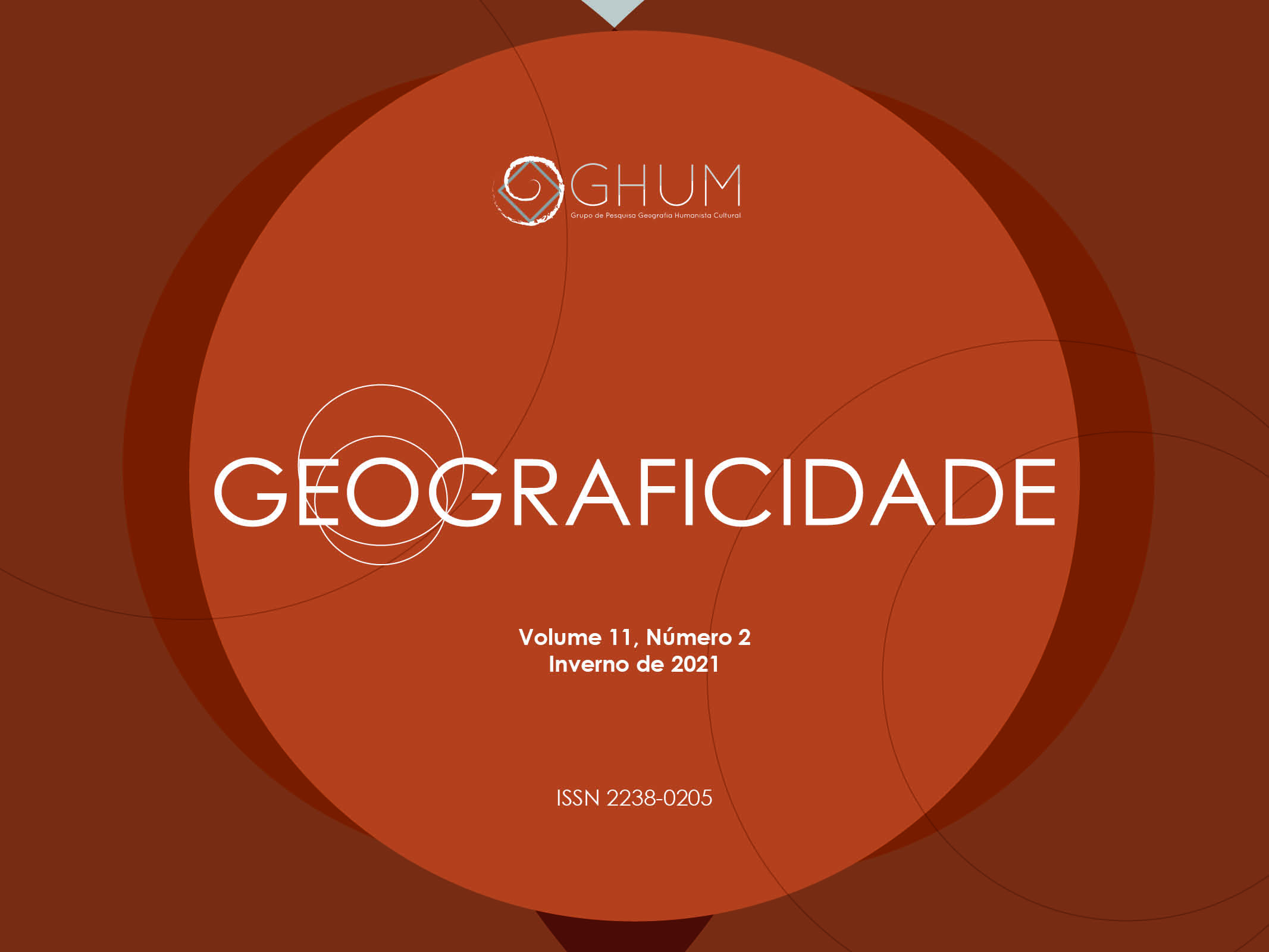A walk through the Goethe's method: first steps for landscape analysis
Keywords:
fenômeno., fenomenologia, geomorfologia, GeografiaAbstract
In science, many paths can be taken to understand a phenomenon. Some of them encourage the walker’s relationship with his path, promoting a keen and even contemplative look at the phenomenon
in question; other paths deter us and distance us from this phenomenon. Seeking to walk with his eyes open and his senses refined so that the phenomena of nature could reveal themselves, Goethe marked out his scientific path constituting his own method of doing science. The Goethian method shows the relationship
between subject and object, considering the experiment as the mediator between both. Therefore, this article seeks to go
through some of the main ideas that serve as the basis of Goethe’s method and share with the readers the first steps taken for the analysis of two landscapes, one in Valinhos-SP/Brazil, and the other in Peterborough-NH/USA, emphasizing the geological and geographic phenomena.
Downloads
References
AB’SABER, Aziz. Os domínios de natureza do Brasil: potencialidades paisagísticas. São Paulo: Ateliê Editorial, 2003.
AB’SABER, Aziz. A terra paulista. Boletim paulista de geografia, n. 23, p. 5-38, 1956.
ALMEIDA, Fernando F. M.; CARNEIRO Celso Dal Ré. Origem e evolução da Serra do Mar. Revista Brasileira de Geociências, v. 28, n. 2, p. 135-150, junho de 1998.
BALDRIDGE, W. Scott. The Geological Writings of Goethe: despite his keen powers of observation, Goethe's ideas on geology reflected the biases of his time. American Scientist, v. 72, n. 2, p. 163-167, mar./abr., 1984.
BORTOFT, Henri. The wholeness of nature. Great Barrington: Lindisfarne Press, 1996.
BORTOFT, Henri. Counterfeit and authentic wholes: finding a means for dwelling in nature. In: SEAMON, D.; ZAJONC, A. Goethe’s way of science: a phenomenology of nature. New York: State University of New York, 1998.
BOSSE, Dankmar. The mutual evolution of earth and humanity. Sketch of a geology and paleontology of the living earth. Trad. Frank T. Fawcett. Great Barrington: Anthrophosofic Press, 2019.
CLOSS, Walther. The living earth: the organic origin of rocks and minerals. Trad. K. Castelliz e B. Saunders-Davies. Great Britain: Lanthorne Press, 1977.
FERRAZ, Maíra Kahl. Contribuições do método morfológico e da estética de Johann Wolfgang Goethe para a epistemologia da geografia. Tese (Doutorado em Geografia) – Instituto de Geociências, Universidade Estadual de Campinas, Campinas, 2019.
GOETHE, Johann Wolfgang. The experiment as mediator of object and subject. Context, New York, p. 19-23, 2010.
GOETHE, Johann Wolfgang. A natureza. In: GOETHE, J. W. Ensaios científicos. Uma metodologia para o estudo da natureza. São Paulo: Barany Editora, 2012. p. 107-110.
GOLDTHWAIT, James Walter; GOLDTHWAIT, Lawrence; GOLDTHWAIT, Richard Parker. The geology of New Hampshire: part I surficial geology. Concord: New Hampshire State planning and development commission, 1955.
GOOGLE Earth, 2018. Valinhos, SP. Coordenadas 22° 58' 15" S 46° 59' 45" O.
HOLDREGE, Craig. Doing Goethean Science. Janus Head, v. 8, n. 1, p. 27-52, 2005.
HOLDREGE, Craig. Thinking like a plant: a living science for life. Great Barrington: Anthroposofic Press, 2013.
JAHN, Ilse. On the origin of romantic biology and its further development at the university of Jena between 1790 and 1850. In: POGGI E.; BOSSI, M. (Eds.). Romanticism in Science. Boston: Kluwer Academic Publishers, 1994. p. 75-89.
JORDÃO, Silvia. A contribuição da geomorfologia para o conhecimento da fitogeografia no estado de São Paulo e da representatividade das unidades de conservação de proteção integral. Tese (Doutorado em Geografia Física) – Departamento de Geografia da Faculdade de Filosofia, Letras e Ciências Humanas, Universidade de São Paulo. São Paulo, 2011.
LESLIE, Clare Walker. Nature drawing a tool for learning. New York: A spectrum book, 1980.
MONADNOCK. Encyclopaedia Britannica, 2019. Disponível em: https://www.britannica.com/science/monadnock. Acesso em: 26 de julho de 2021.
PFEIFFER, Ehrenfried. The earth’s face: landscape and its relation to the health of the soil. Sussex: The lanthor press, 1988.
ROSS, J. L. S.; MOROZ, I. C. Mapa Geomorfológico do Estado de São Paulo. Laboratório de Geomorfologia. São Paulo: Departamento de Geografia–FFLCH–USP/Laboratório de Cartografia Geotécnica–Geologia Aplicada–IPT/FAPESP (Fundação do Amparo à Pesquisa do Estado de São Paulo), 1997.
STEINER, Rudolf. Goethe's conception of the world. London: Anthroposophical Publishing Company, 1928.
STEINER, Rudolf. Le opere scientifiche di Goethe. Milano: Arti Grafiche Luigi Memo, 1944.
VLACH, Silvio Roberto Farias. Geologia e Petrologia dos granitoides de Morungaba, SP. Tese (Doutorado em Geografia) – Instituto de Geociências, Universidade de São Paulo, São Paulo, 1993.
WULF, Andrea. A invenção da natureza: a vida e as descobertas de Alexander von Humboldt. São Paulo: Planeta, 2016.


